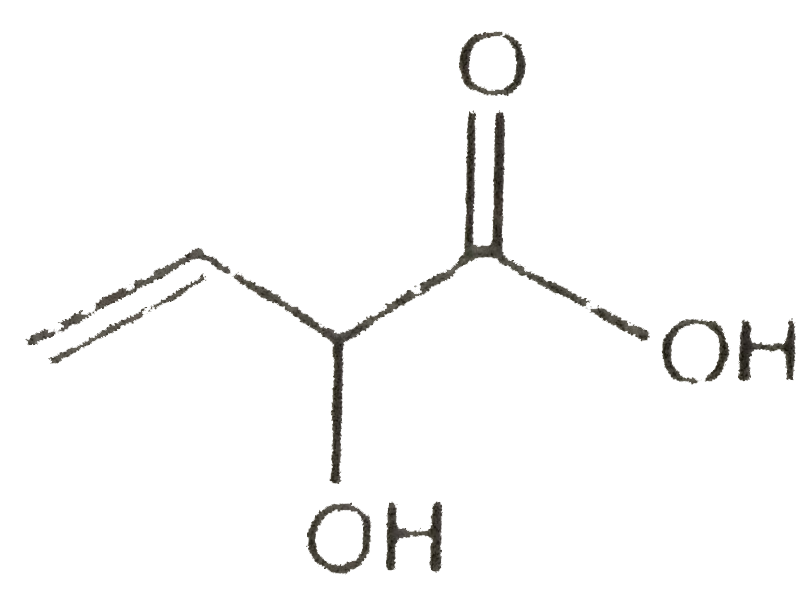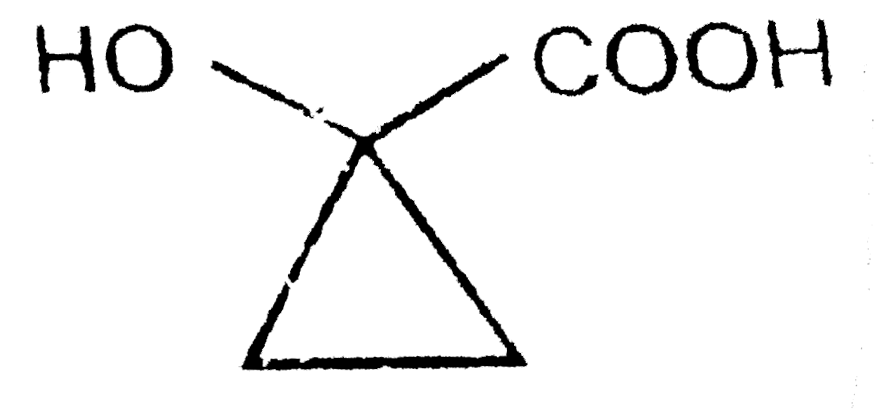There are three isomeric compounds with molecular formula .Compound is a saturated hydroxy carboxylic acid.Compound is a symmetrical anhydride while is an aldehydic ester.
Which of the following is ?




The correct Answer is:D
To determine which compound is P, a saturated hydroxy carboxylic acid with the molecular formula C4H6O3, we will analyze the characteristics of the compounds based on the given information.
1. Understanding the Molecular Formula:
- The molecular formula C4H6O3 indicates that the compound contains 4 carbon atoms, 6 hydrogen atoms, and 3 oxygen atoms.
2. Identifying Compound P:
- Compound P is described as a saturated hydroxy carboxylic acid. This means it must have a carboxylic acid group (−COOH) and a hydroxyl group (−OH), and it should not contain any double bonds or rings (saturated).
3. Drawing the Structure:
- Start by placing the carboxylic acid group on one end of a 4-carbon chain. The structure can be represented as:
HOOC−CH2−CH2−CH3
- Now, we need to add the hydroxyl group. Since it is a hydroxy carboxylic acid, the hydroxyl group can be placed on the second or third carbon:
HOOC−CH(OH)−CH2−CH3
- This structure satisfies the requirement of being saturated and contains both the carboxylic acid and hydroxyl groups.
4. Checking Stability:
- The placement of the hydroxyl group on the second carbon is more stable compared to placing it on the carbon adjacent to the carboxylic acid. Therefore, the most stable structure for P would be:
HOOC−CH(OH)−CH2−CH3
5. Analyzing Other Compounds:
- For compound Q, which is a symmetrical anhydride, it would not fit the description of P since it would contain a different functional group.
- For compound R, an aldehydic ester, it would also not fit the description of P as it involves an aldehyde group.
6. Identifying the Correct Option:
- Based on the structures and functional groups, we can identify the correct structure for P from the options provided. The option that contains a saturated hydroxy carboxylic acid structure with the correct functional groups is the answer.
Conclusion:
The correct answer for compound P, which is a saturated hydroxy carboxylic acid, is the option that contains the structure HOOC−CH(OH)−CH2−CH3.
- The molecular formula C4H6O3 indicates that the compound contains 4 carbon atoms, 6 hydrogen atoms, and 3 oxygen atoms.
- Compound P is described as a saturated hydroxy carboxylic acid. This means it must have a carboxylic acid group (−COOH) and a hydroxyl group (−OH), and it should not contain any double bonds or rings (saturated).
- Start by placing the carboxylic acid group on one end of a 4-carbon chain. The structure can be represented as:
HOOC−CH2−CH2−CH3
- Now, we need to add the hydroxyl group. Since it is a hydroxy carboxylic acid, the hydroxyl group can be placed on the second or third carbon:
HOOC−CH(OH)−CH2−CH3
- This structure satisfies the requirement of being saturated and contains both the carboxylic acid and hydroxyl groups.
- The placement of the hydroxyl group on the second carbon is more stable compared to placing it on the carbon adjacent to the carboxylic acid. Therefore, the most stable structure for P would be:
HOOC−CH(OH)−CH2−CH3
- For compound Q, which is a symmetrical anhydride, it would not fit the description of P since it would contain a different functional group.
- For compound R, an aldehydic ester, it would also not fit the description of P as it involves an aldehyde group.
- Based on the structures and functional groups, we can identify the correct structure for P from the options provided. The option that contains a saturated hydroxy carboxylic acid structure with the correct functional groups is the answer.
The correct answer for compound P, which is a saturated hydroxy carboxylic acid, is the option that contains the structure HOOC−CH(OH)−CH2−CH3.
Topper's Solved these Questions
- IUPAC NOMENCLATURE & STRUCTURAL ISOMERISM BOOK - RESONANCE ENGLISHCHAPTER - IUPAC NOMENCLATURE & STRUCTURAL ISOMERISM EXERCISE - Exercise-3 Part-1
9 Videos
- IUPAC NOMENCLATURE & STRUCTURAL ISOMERISM BOOK - RESONANCE ENGLISHCHAPTER - IUPAC NOMENCLATURE & STRUCTURAL ISOMERISM EXERCISE - Exercise-3 Part-2
8 Videos
- IUPAC NOMENCLATURE & STRUCTURAL ISOMERISM BOOK - RESONANCE ENGLISHCHAPTER - IUPAC NOMENCLATURE & STRUCTURAL ISOMERISM EXERCISE - Exercise-2 Part-3
10 Videos
- IONIC EQUILIBRIUMBOOK - RESONANCE ENGLISHCHAPTER - IONIC EQUILIBRIUMEXERCISE - partIII one or more than one options correct type
10 Videos
- METALLURGYBOOK - RESONANCE ENGLISHCHAPTER - METALLURGYEXERCISE - ORGANIC CHEMISTRY(Alkyl Halide, Alcohol,Phenol,Ether)
17 Videos
Similar Questions
Knowledge Check
A compound X with the molecular formula , C3H8O can be oxidised to another compound Y whose molecular formula is C3H6O2. The compound X may be
Aprimary alcoholBsecondary alcoholCaldehydeDketone
The type of isomerism exihibited by the compound with formula C4H10O is :
View SolutionReduction of hexose A (molecular formula C6H12O6) with sodium borohydride gives compound B and C. Compound B is optically inactive, whereas compound C is optically active. Which of the following is compound A?
View SolutionMolecular formula of a compound is C6H18O3. Find its empirical formula.
View SolutionA compound with molecular formula C6H10O4 on acylation with acetic anhydride gives a compound with molecular formula C12H18O8. How many hydroxyl groups are present in the compound?
View SolutionA compound (X) with the molecular formula C3H8O can be oxidized to another (Y) whose molecular formula is C3H6O2
The compound (X) may be
View SolutionA compound with molcular formula C4H10O3. is converted by the action of acetyl chloride to a compound of molecular mass 190. The original compound (C4H10O3) has
View SolutionThe correct statement about compounds (P), (Q) and (R) :

View Solution
